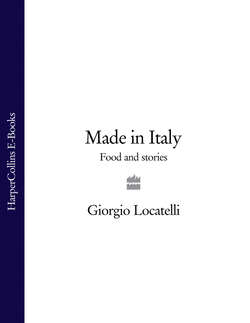Читать книгу Made in Italy: Food and Stories - Giorgio Locatelli - Страница 11
Italian food today
ОглавлениеNowadays in Italy – in the cities at least – like everywhere else in the world, the way people want to eat is changing, though perhaps a little more slowly than everywhere else. Not everyone wants a meal of several courses any more. They want to be more relaxed, so you can order just a bowl of pasta and nobody thinks anything of it. And there are now city bars serving only antipasti, where you make yourself up a plate of whatever you want, and that’s all you have. Then there are the newer, smarter restaurants, which try really hard to make their starters more imaginative than a plate of carpaccio or an insalata caprese (tomatoes and mozzarella).
As for me, I am an Italian chef who has cooked in Paris and come of age in London, and inventive starters are what people expect from me. I might have in the kitchen a salami that is so beautiful it makes you cry, but I can’t just slice it and put it out with some artichokes and bread. I have to present it in a more sophisticated way. We must include such starters in the restaurant, but we can’t lose the pasta course, so the modern Italian menu usually has four sections: starters, pasta, main courses and dessert, which I know can seem daunting. Sometimes customers say, ‘What should I do? Do I have to have a starter, then pasta and a main course after that? Or can I have just pasta and a dessert?’ Of course, you can do what you like; we just try to give a selection of everything an Italian would want to be offered, so you can eat as few or as many courses as you want.
However sophisticated our menu may be at Locanda, it always has its roots in classic regional Italian cooking. Sure, some of our favourite starters have come about, like all good dishes, from getting excited about a particular ingredient that comes into the kitchen, but many of them are simply our interpretation of the traditional elements of the antipasti misti – the artichokes, porcini and cured meats with which I and most of my kitchen staff have grown up. We look at them, rethink them and work at representing them in more imaginative or surprising ways.
The key is always to concentrate on just a few flavours. I think it is terrible to eat out in a restaurant and not remember afterwards what you had because there were too many tastes happening at once on your plate. It is better to buy primary ingredients that have their own fantastic flavour and then you have to do less with them.
One of the great things that has happened since I came to this country is the revolution in the quality of ingredients. When the first Italian immigrants came to the UK and set up their restaurants, they brought what they could over from Italy and created a limited Italian kitchen, making Anglo-Italian dishes that catered for British tastes. Then when people began to be more interested in the genuine food of Italy, and were prepared to pay for real Parmigiano Reggiano and prosciutto di Parma and mozzarella di bufala, the best quality food began to be imported, and producers in this country began to think, ‘We can do this, too.’ So now there is a wonderful mix of high quality Italian and British produce that you can use in your antipasti.
